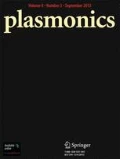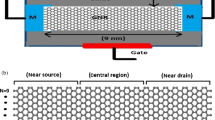Abstract
A novel approach is presented in order to study the effects of carrier generation on the drain-source current of graphene nanoscroll field effect transistors (GNSFET). In this method, ionisation carrier concentration is calculated and included in the drain-source current. In addition, a simulation approach based on Monte Carlo is employed in order to calculate ionisation coefficient. Finally, the current is calculated including ionisation and not including ionisation and compared together at different conditions in order to investigate the effect of ionisation. The results show that this mechanism is not ignorable in graphene-based transistors as it was in most cases in silicon transistors. In addition, the breakdown voltage has been calculated analytically and compared with fabrication results of couterparts in silicon technology.






Similar content being viewed by others
References
Schedin F, Geim AK, Morozov SV, Hill EW, Blake P, Katsnelson MI, Novoselov KS (2007) Detection of individual gas molecules adsorbed on graphene. Nat Mater 6(9):652–655
Dai H (2001) Carbon nanotubes: synthesis, structure, properties, and applications. In: Topics in applied physics. Springer, Berlin
Martel R, Schmidt T, Shea HR, Hertel T, Avouris P (1998) Single-and multi-wall carbon nanotube field-effect transistors. Appl Phys Lett 73(17):2447–2449
Ghadiry M et al (2012) Analysis of a novel full adder designed for implementing in carbone nanotube technology. Journal of Circuits, Systems, and Computers 21(05):1250042
Viculis LM, Mack JJ, Kaner RB (2003) A chemical route to carbon nanoscrolls. Science 299(5611):1361–1361
Khaledian M et al (2014) Carrier statistics and quantum capacitance models of graphene nanoscroll. J Nanomater 2014:101–101
Zhao J, Yang B, Yang Z, Zhang P, Zheng Z, Ren W, Yan X (2014) Facile preparation of large-scale graphene nanoscrolls from graphene oxide sheets by cold quenching in liquid nitrogen. Carbon 79:470–477
Ahmad H, Ghadiry M, Manaf AA (2016) A new approach to study carrier generation in graphene nanoribbons under lateral bias. Mater Express 6(3):283–288
Neto AC et al (2009) The electronic properties of graphene. Rev Mod Phys 81(1):109–162
Khaledian M, Ismail R, Saeidmanesh M, Ghadiry M, Akbari E (2015) Sensitivity modelling of graphene nanoscroll-based NO2 gas sensors. Plasmonics 10(5):1133–1140
Zhong Y, Zhen Z, Zhu H (2017) Graphene: fundamental research and potential applications. FlatChem 4:20–32
Xie X, Ju L, Feng X, Sun Y, Zhou R, Liu K, Fan S, Li Q, Jiang K (2009) Controlled fabrication of high-quality carbon nanoscrolls from monolayer graphene. Nano Lett 9(7):2565–2570
Xu Z, Zheng B, Chen J, Gao C (2014) Highly efficient synthesis of neat graphene nanoscrolls from graphene oxide by well-controlled lyophilization. Chem Mater 26(23):6811–6818
Taji S, Karimi A, Ghadiry M, Fotovatikhah F (2015) An analytical approach to calculate power and delay of carbon-based links in on-chip networks. J Comput Theor Nanosci 12(8):1775–1779
Ghadiry M et al (2011) Design and analysis of a new carbon nanotube full adder cell. J Nanomater 2011:36
Schwierz F (2010) Graphene transistors. Nat Nanotechnol 5(7):487–496
Ghadiry M, Nadi M, Saiedmanesh M, Abadi HKF (2014) An analytical approach to study breakdown mechanism in graphene nanoribbon field effect transistors. J Comput Theor Nanosci 11(2):339–343
Saeidmanesh M, Ghadiry MH, Khaledian M, Kiani MJ, Ismail R (2014) Carrier scattering and impact ionization in bilayer graphene. J Comput Electron 13(1):180–185
Fang T et al (2011) High-field transport in two-dimensional graphene. Phys Rev B 84:125450
Ghadiry M, Manaf ABA, Nadi M, Rahmani M, Ahmadi MT (2012) Theory of ionization mechanism in graphene nanoribbons. J Comput Theor Nanosci 9(12):2190–2192
Park W-D, Tanioka K (2014) Avalanche multiplication and impact ionization in amorphous selenium. Jpn J Appl Phys 53(3):1347–4065
Ghadiry M, Nadi M, Saiedmanesh M, Abadi HKF (2014) An analytical approach to study breakdown mechanism in graphene nanoribbon field effect transistors. J Comput Theor Nanosci 11(2):339–343
Ryzhii V, Ryzhii M, Satou A (2008) Current-voltage characteristics of a graphene-nanoribbon field-effect transistor. J Appl Phys 103:094510
Wang X et al (2008) Room temperature all semiconducting sub-10nm graphene nanoribbon field-effect transistors. Phys Rev Lett 100:206803
Rubel O, Potvin A, Laughton D (2011) Generalized lucky-drift model for impact ionization in semiconductors with disorder. J Phys Condens Matter 23(5):055802
Su V et al (2008) Breakdown behavior of 40-nm PD-SOI NMOS device considering STI-induced mechanical stress effect. IEEE Electron Device Lett 29(6):612–614
Wong H (2000) Drain breakdown in submicron MOSFETs: a review. Microelectron Reliab 40(1):3–15
Sun E et al (1978) Breakdown mechanism in short-channel MOS transistors. In: Electron devices meeting, 1978 International. IEEE. https://doi.org/10.1109/IEDM.1978.189459
Author information
Authors and Affiliations
Corresponding author
Additional information
Publisher’s Note
Springer Nature remains neutral with regard to jurisdictional claims in published maps and institutional affiliations.
Rights and permissions
About this article
Cite this article
Amiri, I.S., Mohammadi, H. & Yupapin, P. A Theoretical Study on the Influence of Carrier Generation on Drain-Source Current of Graphene Nanoscroll Transistors. Plasmonics 14, 1329–1334 (2019). https://doi.org/10.1007/s11468-019-00920-1
Received:
Accepted:
Published:
Issue Date:
DOI: https://doi.org/10.1007/s11468-019-00920-1



